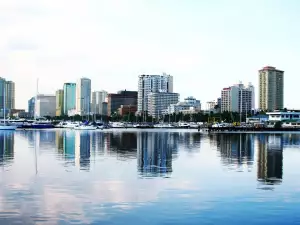Manila

Manila - capital of the Philippines is the most populous city in the world. Although the population is not impressively large (1, 660, 714 people), the townspeople live in an area of only 38.55 square kilometres.
Manila is located on the east coast of Manila Bay. Pasig River bisects the town.
This cosmopolitan capital can safely be called political, commercial, transport, cultural, educational and religious center of the Philippines.
The city has more than 10 centuries of history. In XV century, Spanish conquistadors set foot on Philippine soil. The Spanish conquerors ruled for nearly three centuries, quickly turning Manila into the "Pearl of the Orient", linking Latin America and Asia. Manila, through the centuries has often been shaken by internal insurgency and foreign occupations. Only after the arrival of the Americans, who in 1898 tookg control of the Philippines, a sustainable city began to develop and validate itself by becoming such a prosperous city. This period did not last long. World War II destroyed all that was achieved. Even today, the city is again rebuilt.

The history of Manila remembers some startling events. During World War II, it became the scene of the greatest battle in the Pacific. Manila turns into a bloodbath after the merciless killing of 100 000 civilians.
The capital of the Philippines is the most devastated city after Warsaw.
These staggering events and memory of the heroes and victims in the 10 century history of Manila are reflected in modern monuments of the city.
One of the places in this sense is Rizal Park, built in honour of the Filipino national hero Jose Rizal. Customers define the park as an oasis for relaxation and entertainment in the heart of Manila. On its territory there are gardens, monuments, telling the history of the Philippines, a huge stadium, an observatory, outdoor concert hall, sound-light theatre, numerous restaurants, playgrounds and beautiful fountains. In the park are located some beautiful government buildings.
Malacanang Palace is another place you must visit. The building is located on the north bank of Pasig River and is the official residence of the government.
Religious center and shelter for works of art is the church of Manila Museum of San Agustin. The architecture and interior of the temple carry visitors centuries back. The building is open to visitors every day from 8 to 18 hours, admission is free and however guests are expected to make a donation.

A beautiful religious shrine in the capital is the Cathedral in Manila. The building dates back to 1581.
Among the most famous churches is Quiapo Church. According to historians the church was founded by Franciscan Missionaries headed by Pedro Batista.
Other places you can visit are the buildings of the Supreme Court of the Philippines, National Museum, Manila University and National Library, located in Rizal Park.
The capital of the Philippines has a well-developed industrial area. Overcrowding of Manila, however has some negative consequences.
As already mentioned, the city is crossed by the Pasig River. It turns out that the bed of the river is polluted daily with tons of waste. In 2003, the report states that daily in the water are poured 150 tons municipal and industrial waste 75 tons. The reason for this is lack of adequate infrastructure.
For the visitors it is good to know that the climate in Manila is entirely tropical. This means that the temperature range is very small. In this part of the Philippines, temperatures rarely fall below 20 ° C or rises above 38 ° C.
The capital of the Philippines is one of the sixteen cities forming metropolis Metro Manila (Metro Manila) - extremely popular conglomerate and the 11th largest in the world with a total population of over 16 million people.
North of the capital are the cities of Navotas and Caloocan, with Quezon to the nort-east and San Juan and Mandaluyong to the east.







